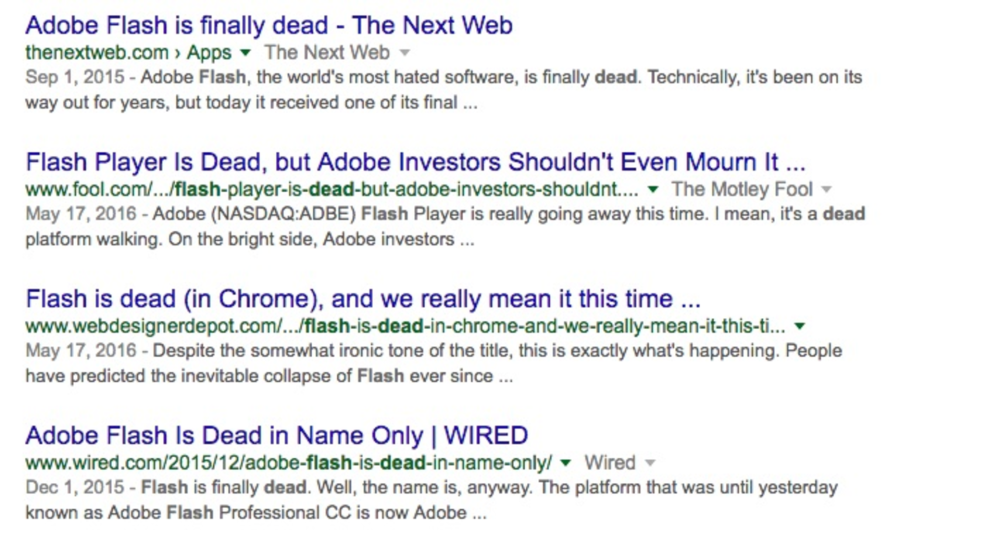The gatekeepers of the Internet may have finally killed Adobe Flash, and that means it’s time to get serious about HTML5.
Since Apple cast the first salvo against Flash in 2010, when Steve Jobs published an open letter addressing issues with the ubiquitous plugin, industry watchers have wondered when Flash would see its final webpage. Given Apple’s considerable influence on the digital zeitgeist, you’d think Flash would be an internet history relic by now, but that’s not been the case. Well, this time it seems real.
Mozilla today announced it will begin pulling its support of Flash in 2017 by instituting a click-to-activate requirement to display Flash media in Firefox. And before that news, on June 30, 2016, Google barred marketers from uploading Flash ads to its AdWords and DoubleClick digital marketing network. Flash ads will cease to run at all on Google’s display network come January, and
In reality, as per the image below, Flash has been dying for quite some time. Every time some partner changed its approach to Flash, the media has said, no, really, Flash is finally dead. And Adobe has long prepared for this day. In November 2015, Adobe posted a message on its website: “Flash, HTML5, and Open Web Standards” that pushed HTML5 and focused its work on Flash as mere maintenance. But Flash multimedia made up 55% of mobile ad impressions in the first quarter of 2015, despite the lack of mobile Flash support (especially on Apple devices), according to a study from Sizmek.
Given Flash’s reputation as one of the most vulnerable security risks on the internet (some 511 reported vulnerabilities since 2005, and counting), it’s been difficult to build a solid defense for the former standard in rich media deployment. But with continued support in web browsers and on ad networks, marketers had few actual reasons to actually fully commit to HTML5.
Now, with Google pulling support of Flash ads, and Mozilla and Microsoft switching to an opt-in approach—which is tantamount to abandonment given the dismal click-through-rates of display ads—marketers have no recourse but to drop Flash once and for all. And if we’re being honest, it’s past time marketers join modern users in collectively embracing HTML5. It is, however, important to acknowledge the challenges involved in making the jump to HTML5.
For all of it’s problems, Flash was fairly easy to use and understand. Adobe was the only name in town and, like Java, many computers and browsers came equipped with Flash as the standard rich media plugin. HTML5 is a bit more complicated.
While Flash is a third-party multimedia plugin with viable application in virtually every facet of digital media, HTML5 is purely web-based, making it a more technical approach, not unlike using CSS3 code in web design. This may prove challenging for some marketers, as the brunt of the work involved in creating and distributing web ads now falls on them. However, once the content is made (and is up to HTML standards) the work is done. Flash is known for having several different versions floating around at once, so HTML5 is a welcomed change for marketers who battled Flash’s version fragmentation and incompatibility issues (likely, everyone).
For Adobe’s part, the demise of Flash on the web means relatively little, as the technology’s versatility makes is essential for other media like games. But, by this time next year, marketers who have leaned on Adobe Flash for their digital ads on the web will likely find themselves on the job boards seeking HTML5 developers.








